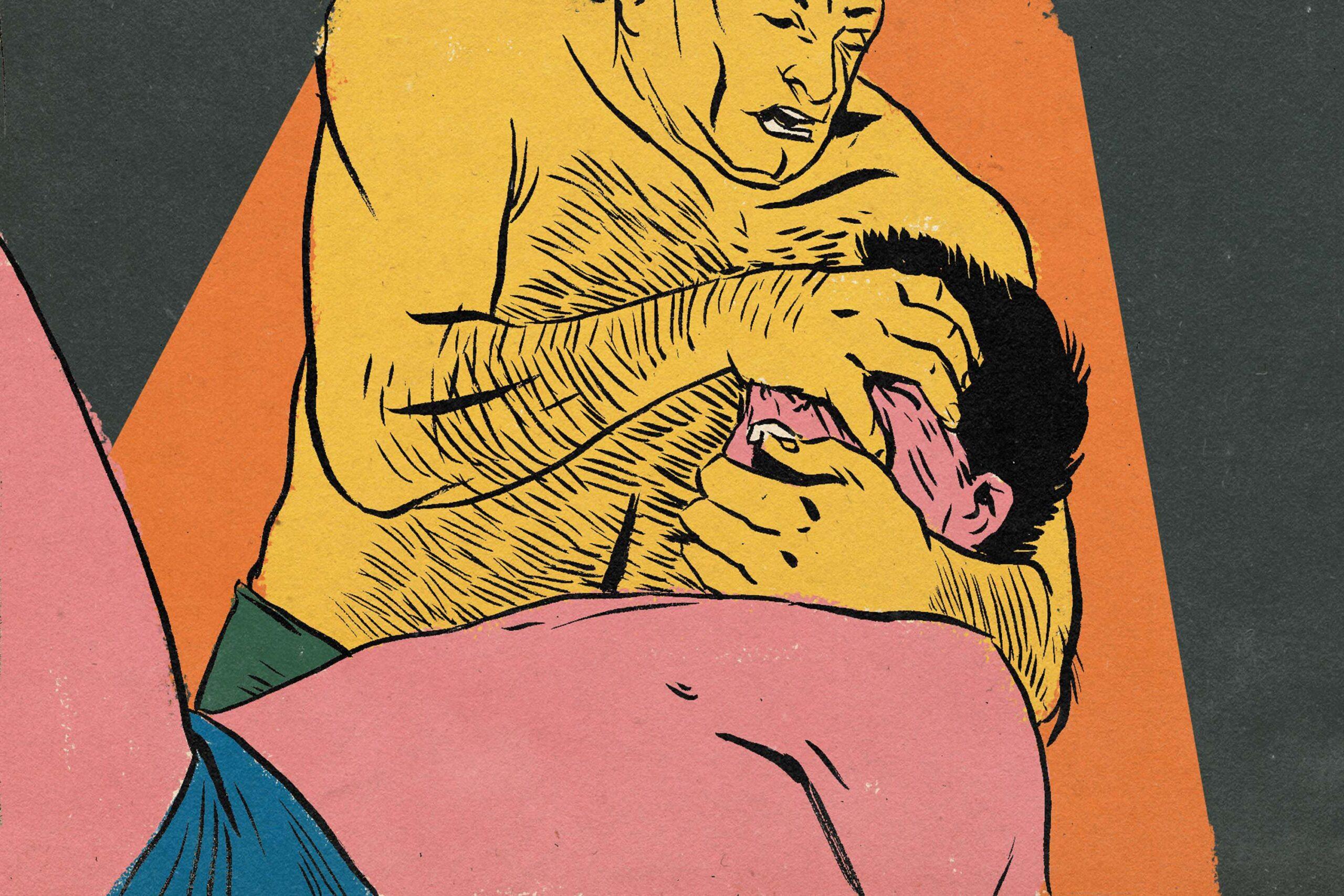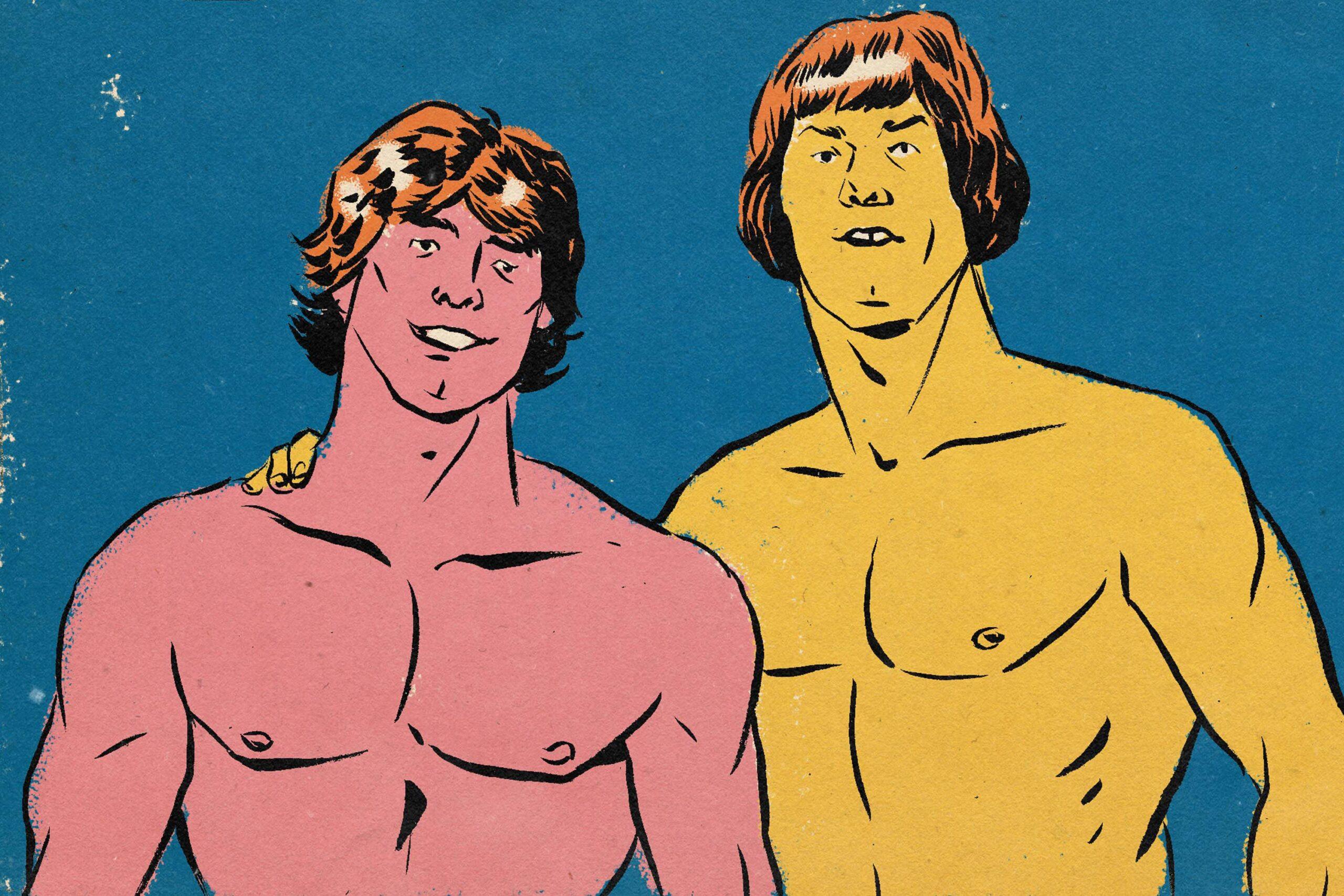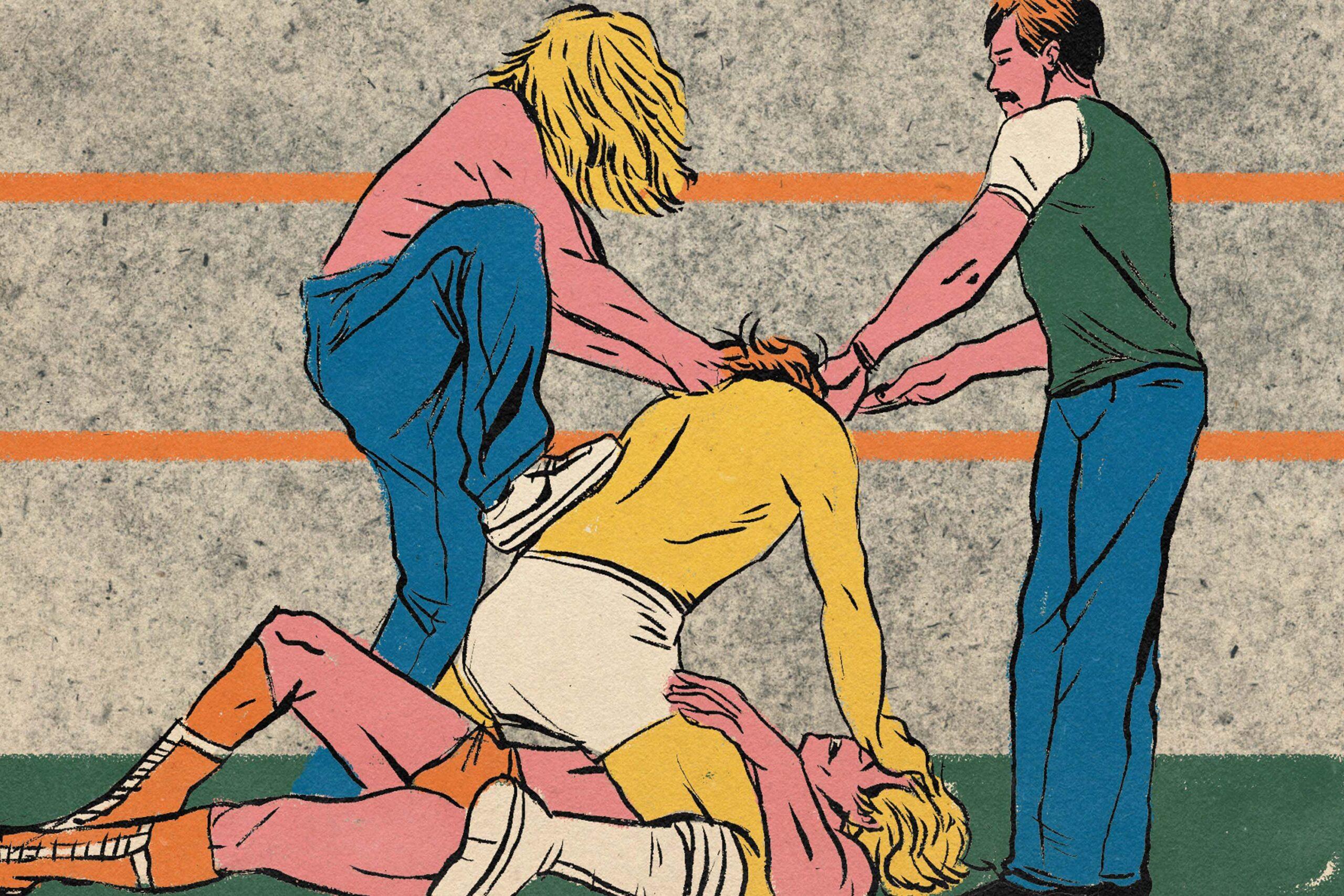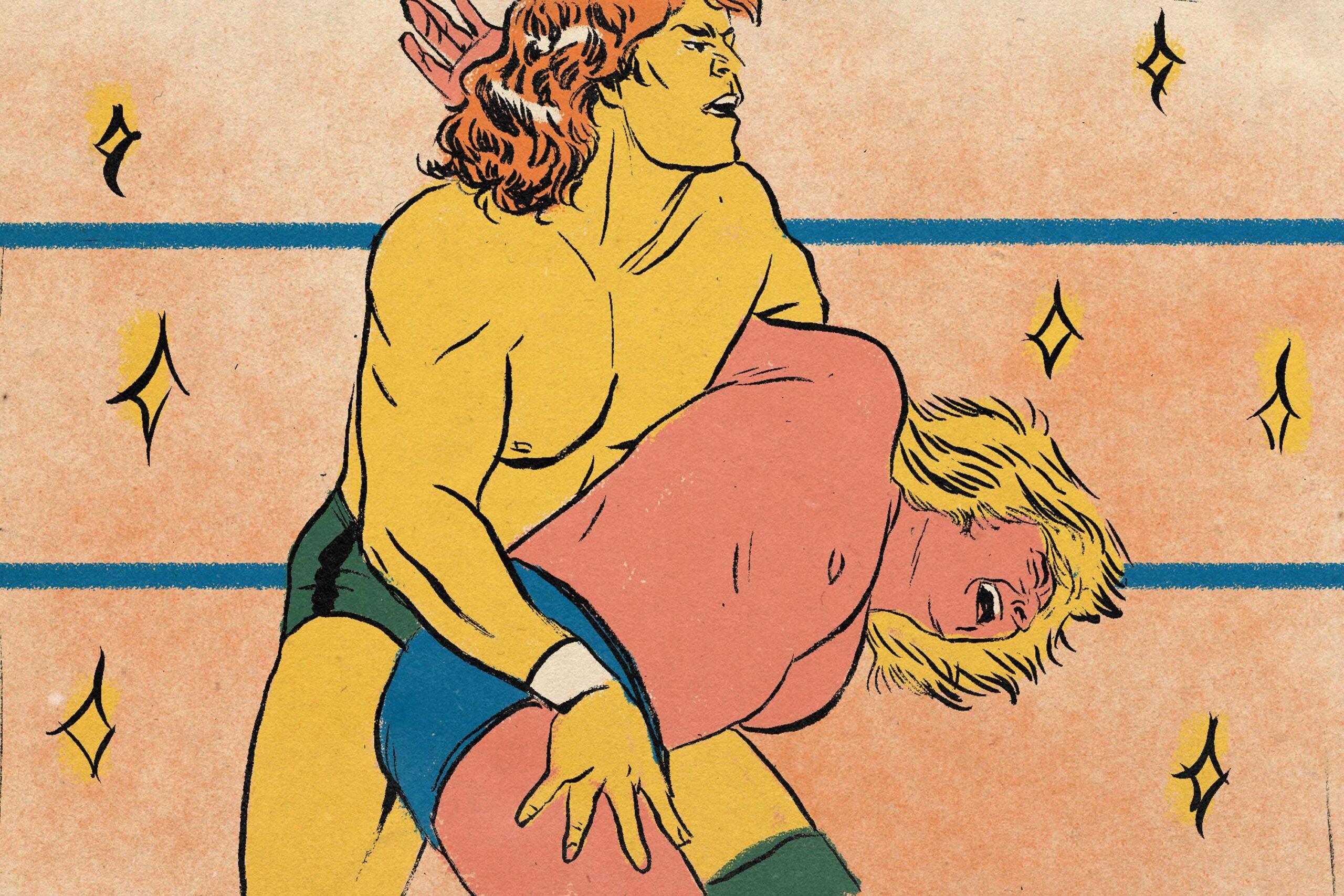This is an excerpt from The Squared Circle: Life, Death, and Professional Wrestling—revised and modified by David Shoemaker with permission from the publisher—to help shed light on the true story of the family on which A24’s The Iron Claw is based. Content warning: This story has mentions of suicide.
Some kids dream about running off to join the circus, ditching their families, their friends, their boring lives, and setting out in search of something different, something new, something exotic. Jack Adkisson was kind of like those kids. But Adkisson didn’t grow up to be a trapeze artist or a lion tamer. He became a Nazi impersonator. And when he came home, he brought the circus with him.
Adkisson grew up playing football in Texas, and he played sparingly in the offensive line that protected the legendary Doak Walker at Southern Methodist University, then briefly for the Dallas Texans before striking out for the Canadian Football League. In Canada, he met another legend, Stu Hart, progenitor of the Hart family of wrestlers and owner of Klondike Wrestling (later to be known as Stampede Wrestling). Adkisson had done some wrestling in Dallas for a brief spell before heading north—it sometimes seems like every football player did back then—and Stu looked at Jack’s enormous frame and blond hair and decided he’d make a good Aryan bully. He paired Adkisson up with a German immigrant’s son named Walter Sieber and redubbed them Fritz and Waldo Von Erich, Prussian Nazis. This was the ’50s, and just like in movies and comic books, Nazis (or, more broadly, evil, nationalist German characters) were still a powerful foil. Neither Jack nor Walter was really a Nazi, but in the wrestling world, fact is rarely a disqualifier. The two toured the country, wrestling in many regional promotions that had grown up in recent years, turning the still-palpable resentment toward the Axis powers into box office gold. Few heels in those days were as despised as the Von Erich brothers, but that animosity wasn’t necessarily misplaced; by some accounts, the vitriol wasn’t so much based in the fans’ belief that the Von Erichs were Nazis but in anger that the wrestlers would seek to commercialize and monetize those fresh wounds—semi-literally, as any wrestling crowd in those days was sure to count a hearty contingent of veterans in its number.

The character suited Adkisson. He was known to be a brute in the ring and a bully outside of it. He roughhoused with his opponents and pushed around fans; he seemed to take delight in imposing his physical will on the world. It should be said that this is not an unusual character type in the wrestling world; Fritz, though, was notorious even in those brawny circles. As frequent opponent (and Mid-South Wrestling mogul) “Cowboy” Bill Watts once put it, “The German gimmick was a natural. With that scowl of his, he was an easy guy to hate.” Like so many other tropes in the wrestling world, the Nazism was a lie told to advance a greater truth about the existence of evil in the world and the need to overcome it with headlocks and such. It was a lie that Jack Adkisson embraced.
There’s a wild, apocryphal story about Fritz sitting in the dressing room in Chicago after a card. It was late. The rest of the wrestlers were busy taking down the ring. A small man appeared at Fritz’s door and asked him about his service in the war. Fritz gruffly told the guy to go away. When the man persisted, Fritz told him it was an act—a gimmick—and the man wondered aloud if Fritz knew that “gimmick” was derived from a Yiddish word. Fritz and the man went back and forth a few more times, with Fritz getting increasingly frustrated with the man’s quiet insistence that Fritz realize the gravity of his offensiveness. Finally, Fritz threatened the man one last time, and the man rolled up his sleeve to expose the tattoo that proved him to be a survivor of the Holocaust. He told Fritz that he’s lost all seven of his sons in the death camps and said ominously that he sincerely hoped that nothing like that would ever happen to Fritz. Adkisson went pale and tossed the man out of the locker room, running him into the door frame, cutting his arm, and tearing his coat, from which fell a scrap of cloth with a six-pointed star imprinted and a few drops of the man’s fresh blood. By the time Fritz looked up, the man had vanished. A locker-room attendant watched the scene from the shadows and recovered the patch from the trash can after Fritz left.
Of course, the wrestling world is a world of mythology, and even its “real life” side is filled with its own myths, legends, and tall tales. But this story stands out not just for its allegory but also for its angle. Almost all of wrestling’s fables are written by its historical victors. Rarely do you hear tales in which the player—Fritz in this case—isn’t depicted in a good light or doesn’t have something to gain by its retelling. To be sure, this isn’t a widespread story, but its very existence is telling: As hard as he would try over the rest of his life to script reality to suit his fantasy, Adkisson would never wholly succeed.
In 1959, Adkisson’s firstborn son, Jack Jr.—called Jackie—died at the age of 6 after being accidentally electrocuted by a neighbor’s trailer and falling face-first into a puddle of melting snow, where he drowned. Fritz and Waldo didn’t strictly split up when Jack Jr. died, but Fritz stopped traveling as much and decided to leave Niagara, New York, where Doris, his wife, had been raising the boys as Fritz fought throughout the region. Both “brothers” took their fearsome German characters with them—Fritz with his Sieg Heil and dreadful Iron Claw finisher, Waldo with his goose step and cartoon villainy. (Waldo, left to his own devices, would go on to a fairly significant career, notably with fan favorite Bruno Sammartino.) Fritz moved on to St. Louis, where he worked for Sam Muchnick, the National Wrestling Alliance macher in the area. Muchnick was a central figure in the NWA power structure, and for years, as long as the power in the Northeastern wrestling scene remained scattered, Muchnick was the closest thing they had in those days to a pro wrestling godfather.
Fritz finally decided to go home to Texas to get a real job and quit playing around with the fake fighting, but he couldn’t quite let the fantasy go. He decided to work a match or two for Ed McLemore at the Dallas Sportatorium to make some cash and ended up backing into an ownership stake in the promotion. Just as in any other consortium of that ilk, who you know is always as important as what you know: Jack’s old boss Muchnick had the sway to give him the approval he needed, in that oddball underworld, to take the reins there. Von Erich partnered with McLemore and split off from Paul Boesch’s South Texas office. After McLemore died, Fritz took control. By the ’80s, Fritz was a local legend—between his wrestling fame, his place in local football lore, his born-again Christianity, and his real estate dealings, Fritz was a proud member of Dallas’s upper crust—and Fritz Von Erich went from Teutonic heel to Texas hero.
It took coming home for Fritz Von Erich to find himself. It’s probably more accurate to say that Fritz Von Erich found himself by embracing his inner Jack Adkisson. After all, Jack was from Texas. Jack’s dad was a constable, for Pete’s sake. How’s this for a subconscious act of rebellion: Jack Adkisson—good ol’ Texas boy, son of a lawman, SMU footballer—went up to Canada and became a Nazi. He finally came home, but he never gave up the Von Erich name. He had chosen pro wrestling over family.
But soon he would have a family of his own, a battling troupe of Von Erich boys built in his image, molded into Texas royalty by the exposure afforded to them in the World Class Championship Wrestling territory. That territory, it was going to be their whole world.
Kevin Von Erich—the eldest son after Jackie died—started wrestling for his dad in 1976. David followed a year later but beat Kevin to wrestling stardom because Kevin was busy playing college football. (David dropped out of school after he got the wrestling bug.) David was the superstar from the start, 6-foot-7, strong and agile, and compelling on the microphone—the complete package, a pre-steroid-era wrestling messiah. He wrestled—and defeated—NWA champ Harley Race in 1979 in a nontitle bout, an indisputable sign of future megastardom. In a stride of individualism unusual for the Von Erich progeny, David defiantly left Texas for a few years early in his career and wrestled around the country, where he earned credibility among the big names of the era and, mostly by playing a bad guy, learned much of the ring psychology that his brothers never mastered. He followed in his father’s footsteps, against his father’s wishes, and only in doing so was he poised to surpass his father.

The other brothers followed their dad’s decree and never left home. Kevin was barefoot and bowl-cut, the highflier of the family, a free spirit who would eventually become its emotional rock. After David came Kerry, the muscle-bound Prince Valiant with sleepy eyes and a powerful sort of charisma that emanated from his posture (and certainly not from his promos—Kerry was always halting on the mic). Then came Mike and then Chris, the former the smallest of the bunch who frequently wrestled, the latter the smallest full stop. Chris dealt with medical issues that left him undersized and with brittle bones; Mike, though healthy, wasn’t as physical as his older brothers and was transparently outmatched by most of his opponents in the ring. If the first lie of the Von Erich family tree was Fritz’s Nazism, the second was Mike’s legitimacy. It wasn’t that he had no business being in the ring; it was that he had no business being successful in the ring, being booked as anything but an underdog, and the Von Erich brothers were largely put over as superheroes. Even to the believing eye and even during his brief physical peak, his tiny frame stacked with suspicious muscles, Mike wasn’t the character he was portraying. He wasn’t up to the standards of David or Kevin or Kerry and certainly not the mythic specter of Fritz. But the fans didn’t object; they were too enthralled by the Von Erich clan to question.
In the territorial era, in the world before international interconnectivity, the local wrestling stage was, by and large, the wrestling stage. After wrestling stopped airing on DuMont and before it came back on national cable networks, many regional promotions had TV shows that aired throughout their local territories. Even if fans in each area thought that they were watching the biggest wrestling show in the country, no territory was more rapturous about the local heroes than Dallas.
There wasn’t any absence of charisma in pro wrestling in those days: Harley Race was around, Ric Flair was ascendant, and Dusty Rhodes was splitting his time between his Florida territory home, sellout houses all over the South, and Vince McMahon’s New York City, where he battled against “Superstar” Billy Graham. But the heroes and villains up till then had been full-grown men, guys who had largely had careers in sports or the military before coming to wrestling, or at a minimum guys who had paid their dues wrestling through the territories, moving up from jobber to supporting act to tag team player before climbing up to the singles-champ tier.
But Fritz had control of Texas and had a different vision: If he was too old to be the star himself, he would push his boys as the stars. It was the standard modus operandi in the territories for the biggest star to be co-owner of the promotion. It was a vicious cycle: The bosses would give the wrestlers a stake so as not to risk them leaving, and then the owner-wrestlers would stay on top interminably because they were the only
people they could trust not to leave. Fritz was only one of many who positioned their sons as heirs apparent to the throne for the same practical (and, one assumes, egotistical) reason. But he was by far the most successful at turning his sons into stars.
David, Kevin, and Kerry toured around the Southwest together, causing Beatles-level crowd freak-outs at their every entrance. Fans of the old WCCW programming on ESPN might recall the fairly shocking sight of those Von Erich boys wading through the throngs of wrestling fans—not just guys, not just nerds, but real, everyday people—in Dallas’s Sportatorium, in Texas Stadium, wherever they could hold a frenzied mob, and being treated like conquering heroes. (The Sportatorium is one of the most legendary venues in pro wrestling history, but it was little more than a barn with a fancy name, a ramshackle setup with wobbly risers, exposed rafters, and no AC. The way they could make it look like a massive arena on television was a testament to pro wrestling’s ability to mythologize in real time.) Women in the crowd grabbed them and kissed them—Kevin says he’d sometimes walk through the crowd with one hand over his mouth and one over his crotch—and handed them bouquets of yellow roses on the way to the ring.
People like to call successful wrestlers “rock stars,” and it’s an overstatement despite being a metaphor. But these kids, they were rock stars. Even that slightly underestimates the reality of their stardom because Texas didn’t have rock stars, really; they only had football. And for a few years in the ’80s, the Von Erichs were bigger than the Dallas Cowboys. Sure, they were sheltered, but their shelter was a body-slam paradise. That little enclave in Dallas, Texas, might have been the only world they knew, but they had that world on a proverbial string. Or, to put it another way, they ruled the Southwest with an Iron Claw.

The three eldest Von Erich boys—sometimes with Fritz at their side—were such straightforward good guys that goodness itself was their organizing attribute. “We were ourselves,” says Kevin in the WWE’s Triumph and Tragedy of World Class Championship Wrestling documentary. They never needed to play a character; they were beyond characters—they were Von Erichs, after all.
They feuded with all sorts of baddies that Fritz imagined up or imported from other territories. Their most memorable rivalry was with the Fabulous Freebirds, a trio of toughs who repped the state of Georgia in the same way that Fritz once did Germany. Michael “P.S.” Hayes was the fancy-boy frontman, Buddy “Jack” Roberts was the unstoppable little asshole, and Terry “Bam Bam” Gordy was the brutish man-child. Hayes came in first and won over the crowd with a variation on the bleached-blond, jive-talking white-man act that had worked for both Dusty Rhodes and Billy Graham (among many others) but soon imported his cronies Roberts and Gordy and turned against the Von Erich clan in a legendary match on Christmas night in 1982. Kerry was wrestling Ric Flair with Hayes as the guest referee, and Hayes assaulted Flair to try to help Kerry win. Kerry refused the tainted victory, and in response, Gordy slammed the cage door on his head. Impossible as it sounds, at that moment in Dallas, the world champion was an afterthought in the match. The feud was epic, and the gritty irreverence of the Freebirds played perfectly off of the Von Erichs’ institutional innocence. They played it as a Texas vs. Georgia issue, a matter of regional pride akin to a college football rivalry, but the subtext was good vs. evil. If, to the modern eye, the comparison to the Freebirds underscores the Von Erichs’ robotic heroism, that was beside the point in 1982. This was still unequivocally the territorial era, the premodern wrestling world, a time of simple duality where feuds were closer to “Nazi Prussian versus American hero” than anything more nuanced.
Things weren’t always simple for the Von Erichs, and the good guys sometimes got the worst of it. In early 1984, David—at just 25 years old—was without his brothers on the first night of a tour through Japan. The morning after he arrived, he was found dead in his hotel room. The first reports in the Dallas papers called it a stroke. Referee David Manning, who was on the trip, says that David ate so much the night before, he wouldn’t be surprised if he had taken some painkillers and choked on his own vomit.
The Japanese coroner eventually called it acute enteritis, a disease of the intestines, which may or may not have triggered a heart attack, depending on who you listen to. The widespread rumor was that the death was drug-related. Ric Flair’s autobiography implies that Bruiser Brody (who also died a tragic death, stabbed backstage at a wrestling event in Puerto Rico in 1988)—also on the trip, in Flair’s telling—flushed David’s stash before the police showed up. Reporting from a local show after David’s death, the Dallas Times Herald keyed on the uncertainty promulgated by the unreal world that the wrestlers inhabited: “The rumor of death hung over the
crowd like the cigarette smoke in the Sportatorium arena on Industrial Avenue Friday night. He was killed, one said. A drug overdose, said another. Many dismissed it all as a wild rumor or a publicity stunt.”
The Von Erichs, ever intent on maintaining their act in public, even in the face of tragedy, said he’d gotten a “hard lick” in a match, and that led to his death, but he hadn’t even wrestled yet in Japan. That was their third lie.
With the huge success of the Dallas promotion and his sheer talent, David had been in line for a run with the NWA championship. After his death, both the Texas territory and the NWA overall were thrown into disarray. A supershow in Texas Stadium in May 1984 was meant to have David winning the NWA title from Flair, and Flair all but admitted it in an on-screen promo that purported to extol David’s talent but that alluded plainly to reality: “I can tell you right now, he was close to being the world’s heavyweight champion.” The plan was rewritten to put Kerry in David’s slot, and Fritz came out of retirement to team with Kevin and Mike against the Freebirds. The venue was packed; 50,000 people strong came to pay tribute to the Von Erich family. Fritz and Co. beat the Freebirds, and Kerry won the belt in almost inexplicable fashion with the most unspectacular conceivable maneuver—not the Iron Claw, but a simple backslide pin. It was an affecting match, but that ending was perhaps coincidentally somber. The crowd cheered his win, but it seemed even they could tell that it was a tribute to David and not a real victory for Kerry.

His title reign didn’t last long (18 days, to be exact); on the national scene, he quickly earned a reputation for being “flaky,” which in just about every retelling is a word laden with implications of drug use. Despite his innate charisma, Kerry didn’t have the verbal prowess or ring psychology of his father or David. He was the dumb jock of the family, slightly Neanderthal in both looks and spirit, and the villains in World Class weren’t shy about pointing it out—pretty-boy heel Gino Hernandez would call Kerry a “baboon brain,” and Michael Hayes once said that “he’s just as stupid as he looks. It takes him an hour and a half to watch 60 Minutes.” In the end, Kerry’s win could do little to dampen the depression that was setting in with the Von Erich clan and its fans.
Mike Von Erich was only ever conscripted into main event duty because of David’s death. The Von Erichs were a three-man unit, and purportedly, Fritz pressured Mike into the role, despite the fact that his only ambition in wrestling was to be a cameraman. In 1985, during a tour of Israel, Mike hurt his shoulder and, after surgery, ended up with toxic shock syndrome. He survived a near-death scare, but he was left weakened and with brain damage. On their TV show, Fritz valiantly predicted an imminent return to the ring. Months later, Mike would appear, bone-thin and glassy-eyed, announcing his full recovery. He did return, but as a shadow of his former self.
His roster of sons depleted, needing to fill Mike’s spot on the card, Fritz birthed a new kin. In late 1985, he unveiled Lance Von Erich to the world—a Von Erich cousin, he called him, Waldo’s son. Everybody knew it was a put-on, not least because William Kevin Vaughan was a local footballer whom most fans recognized. But everybody knew that wrestling was fake. They just didn’t want to be insulted. Fritz soon recanted, admitted on air that Vaughan was never a Von Erich, and promised never again to speak his name.
On June 4, 1986, Kerry wrecked his motorcycle, crushing his right leg. The doctors saved his mangled foot—and, in an unfortunate echo of Mike, Kerry videotaped a guarantee of full recovery that aired on WCCW television. But after surgery, he reinjured his foot. The Von Erich family account is that, in the hospital, doped up, he tried to walk across the room; the conspiracy theorists insist that the foot was reinjured when he attempted a comeback ahead of schedule, shot up with painkillers to get him through the pain. Regardless, after the reinjury, his right foot was amputated. (Or at least partially amputated.) Nobody outside of the hospital staff and the Von Erich family could know about that, though. It didn’t fit with the story line.
After his own surgery, Mike had had several run-ins with the law for increasingly odd and unpredictable behavior—reckless driving, disorderly conduct, etc.—but in April 1987, he was pulled over and found to have two bottles full of nonprescription pills. The Von Erich family lawyer bailed him out. A few days later, on April 12, 1987, Mike deliberately overdosed on sleeping pills and ended his life.
On Christmas night in 1987, at the annual WCCW Star Wars show, the Von Erichs were battling Freebirds Terry Gordy and Buddy Roberts and their associates “Iceman” King Parsons and the Angel of Death. Fritz tried to help but was beaten down; upon exiting the ring, he collapsed dramatically. He seemed to be faking a heart attack, but the Von Erichs claimed that it was a mere collapse from exhaustion and that nothing in such poor taste was implied.
When David died, the fans stuck with the Von Erichs. When Mike was hurt, then Kerry was hurt, and when Mike died, the Dallas fans were squarely in the Von Erich corner. But with Lance Von Erich and then Fritz’s “heart attack,” the Von Erichs had turned their backs on the unspoken agreement between the actors and the audience. They treated the fans as dupes instead of coconspirators. As World Class staggered onward, they were for the first time facing a wary audience. With the audience within the comfortable confines of the Sportatorium waning, the world outside seemed to turn on the Von Erichs, too.
In 1990, Kerry was hired by the WWF and wrestled there to fleeting acclaim. He stuffed the bottom of his right boot and laced it tight, and the world was unaware that he was working on one foot. It was undoubtedly excruciating, and it’s little surprise that this is when widespread rumors of Kerry’s painkiller abuse began to surface, along with rumors of cocaine and other illegal drugs—but it’s also probably no coincidence that these rumors were only allowed to surface once he was out from under the protective umbrella of his father’s Dallas kingdom. He looked like the perfect WWF wrestler, but the company didn’t commit to him. In an echo of his winning of the NWA title from Flair, Kerry won the Intercontinental Championship from “Mr. Perfect” Curt Hennig and lost it back to him three months later.
On September 12, 1991, Chris Von Erich, the smallest of the family, shot himself in the head in a remote area of the family ranch. He had wanted to be a wrestler more than any of his brothers, probably, but—aside from a few feel-good tag team bouts, one of which left him severely injured—he couldn’t do it. And he had been closer to Mike than anyone. Kevin and their mother found him.
By 1992, Kerry had come back to Texas. He wrestled in the Global Wrestling Federation, which had staked its claim on the foundering Dallas territory. Kerry too had run-ins with the police, and when he was arrested in January 1993, he knew that a lengthy jail term was on the horizon. He went to his dad’s house, told him he was going for a drive, and then shot himself in the chest under the tree that all the Von Erich brothers had played on in their youth. That was February 18, 1993.
When they held his memorial service, his name was still on the marquee outside the venue where he was scheduled to wrestle that weekend. His opponent, in perfect wrestling tragicomic irony, was the Angel of Death.
Fritz died in 1997 of brain and lung cancer. When the family was inducted into the WWE Hall of Fame in 2009, Kevin accepted all six rings himself.
